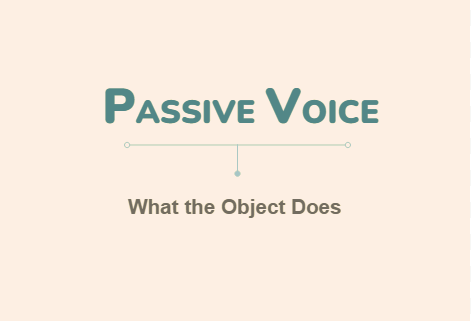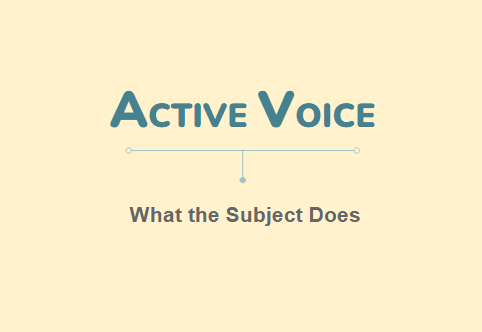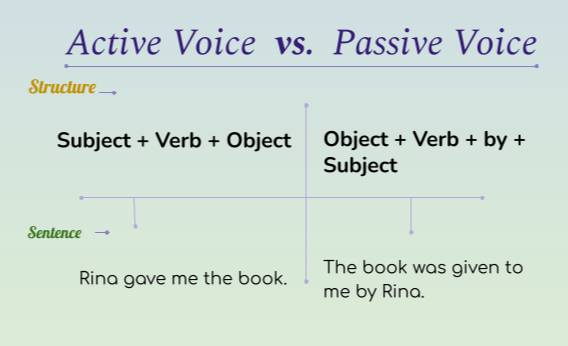Passive Voice

Changing Active to Passive Voice is considered relatively harder but correctly changing them from passive to active is no small deal either. Having a clear conception of the sentence structures in these two voices separately can ease the hurdle.
Passive Voice
In Passive Voice, the action comes into focus and the subject is often not mentioned. The events in the passive sentences are described from the object’s side. The Subject is the one affected here and the Passive Verb and the preposition indicate that the Object is actually the actor. The sentence structure in the Passive Voice:
Subject + Passive Verb + Preposition + Object (Actor)
- Something will be found by him in time.
- The book I was looking for was given to me by Rina.
- All the latest movies are watched by me.
The Subjects of the sentences above are being affected by the Object or the one making things happen or the actor. Passive voice is precisely used to express the other side of the story. Passive sentences are often used in English to overcome the monotonous use of regular sentence formation in speech and writing. But it is usually used in situations where the focus needs to be more on the action and less on the actor.
Universal Passive
was/were born
- She was born in Berlin in 1980.
- You are environmentally conscious because you were born in a coastal region.
Note: There is no active form of this statement since being born itself is a passive act. When someone’s birth year is in the discussion, they are the ones in focus but the passive action of being born happened to them is of the most significance - this is where the universal passive comes into play.
Transformation of Sentence: Passive to Active Voice
Being able to expertly transform sentences across these two voices gives the practitioners of the English language an edge. The flexibility gained by practicing this transformation of sentences lets them exhibit an upper hand when it comes to the versatility of language use.
Present Simple Tense
In terms of present simple tense, am/is/are + past participle verb will be replaced by the base form of the verb in the active voice. Sentence structure in the Active Voice would be -
Subject + Base Verb + Object
Passive voice: My grandparents are visited by me every week.
Active voice: I visit my grandparents every week.
|
Passive |
Active |
|
am/is/are + visited |
visit |
Past Simple Tense
To change the past indefinite sentences from passive to active, was/were + past participle will become the past indefinite form of the base verb in the active voice along with the usual subject-object switches and omission of the preposition. Sentence structure in the Active Voice would be -
Subject + Past Simple Verb + Object
Passive voice: The park was renovated by the municipality.
Active voice: The municipality renovated the park.
|
Passive |
Active |
|
was + renovated |
renovated |
Present Continuous Tense
Changing the present continuous sentences from passive to active, is/are + being + past participle in the passive voice will become is/are + present participle in the active voice along with the usual subject-object switches etc. Sentence structure in the Active Voice would be -
Subject + is/are + Present Participle Verb + Object
Passive voice: The trees are being looked at by Reese.
Active voice: Rease is looking at the trees.
|
Passive |
Active |
|
are + being + looked |
is + looking |
*The auxiliary verbs change according to the subject of the sentence.
Past Continuous Tense
While changing the past continuous sentences from active to passive, was/were + present participle will become was/were + being + past participle in the passive voice along with the usual subject-object switches. Sentence structure in the Active Voice would be -
Subject + Was/were + Present Participle Verb + Object
Passive voice: The piano was being played by Sally.
Active voice: Sally was playing the piano.
|
Passive |
Active |
|
was + being + played |
was playing |
Present Perfect Tense
For changing the present perfect sentences from passive to active voice, have/has + been + past participle in the passive voice will become have/has + past participle in the active voice as for verb conjugation. Sentence structure in the Active Voice would be -
Subject + Has/have + Past Participle Verb + Object
Passive voice: A pair of neon socks have been worn by Harry.
Active voice: Harry has worn a pair of neon socks.
|
Passive |
Active |
|
have + been + worn |
has + worn |
*The auxiliary verb changes according to the subject of the sentence.
Past Perfect Tense
To change the past perfect sentences from passive to active, had + been + past participle in the passive voice will become had + past participle in active sentences. Sentence structure in the Active Voice would be -
Had + Past Participle Verb
Passive voice: The tub of ice cream had been eaten by you.
Active voice: You had eaten the tub of ice cream.
|
Passive |
Active |
|
had + been + eaten |
had + eaten |
Future and Optative Sentence
These two types of sentences change in the same manner between passive and active voice. The Modal Auxiliaries are carried into the active sentences and be + Past Participle Verb is replaced by the base verb.
Will / Shall / Can / May / Must
Verb conjugation in the Active Voice would be -
Will/shall/can/may/must + Base Verb
Passive voice: The office lawn must be mowed.
Active voice: You must mow the office lawn.
Passive voice: The air conditioner will be bought this month.
Active voice: The office will buy the air conditioner this month.
Have / Has / Had To
Verb conjugation in the Active Voice would be -
Have/has/had to + Base Verb
Passive voice: The memo has to be written.
Active voice: I have to write the memo.
Grammar
Read More
- How to Use "Therefore" in Sentences Avoiding Common Mistakes
- How to Use "Whereas" with Examples and Avoid Common Mistakes
- When and How to Use "Thus" Correctly Without Common Mistakes
- How to Use "On the Contrary" Properly with Meaning and Examples
- When and How to Use "Either/Or" with Examples and Common Mistakes to Avoid
- How to Use "On the Other Hand" Effectively without Mistakes
- How to Use "Respectively" with Example and Common Errors to Avoid
- How and When to Use "Moreover" Without Mistakes
- How to Use "Likewise" in Sentences Based on Context & When not to Use
- When & How to Use "Although" in Sentences to Avoid Mistake


